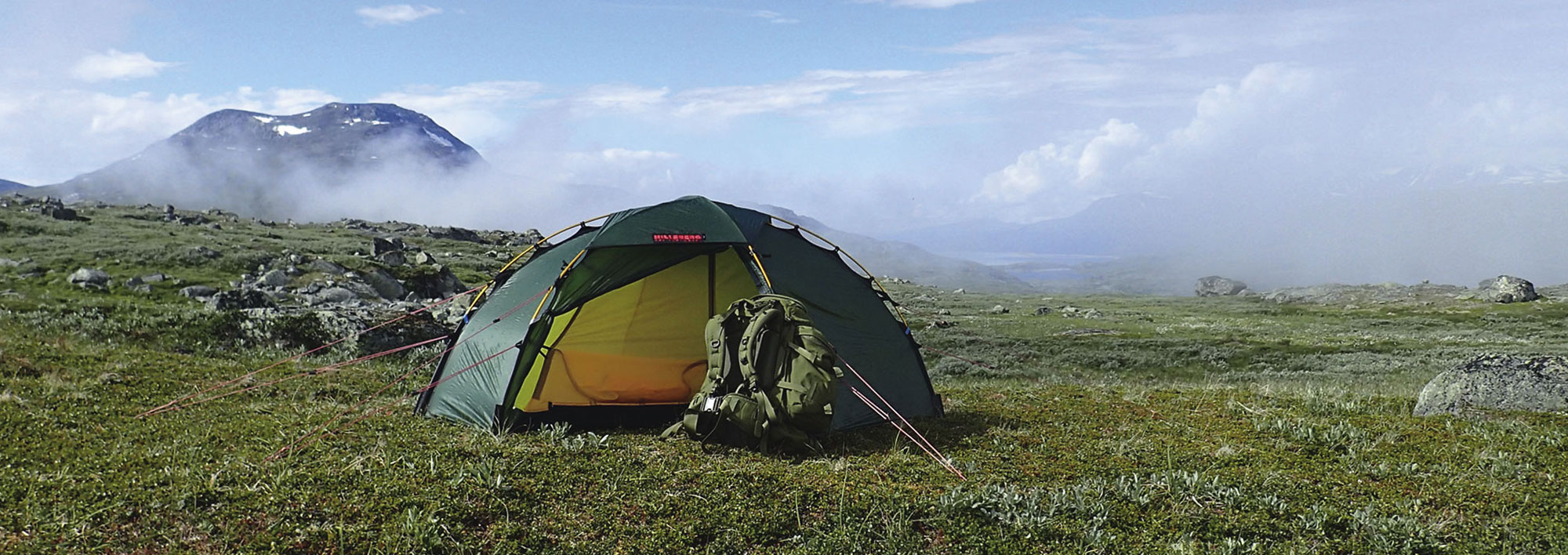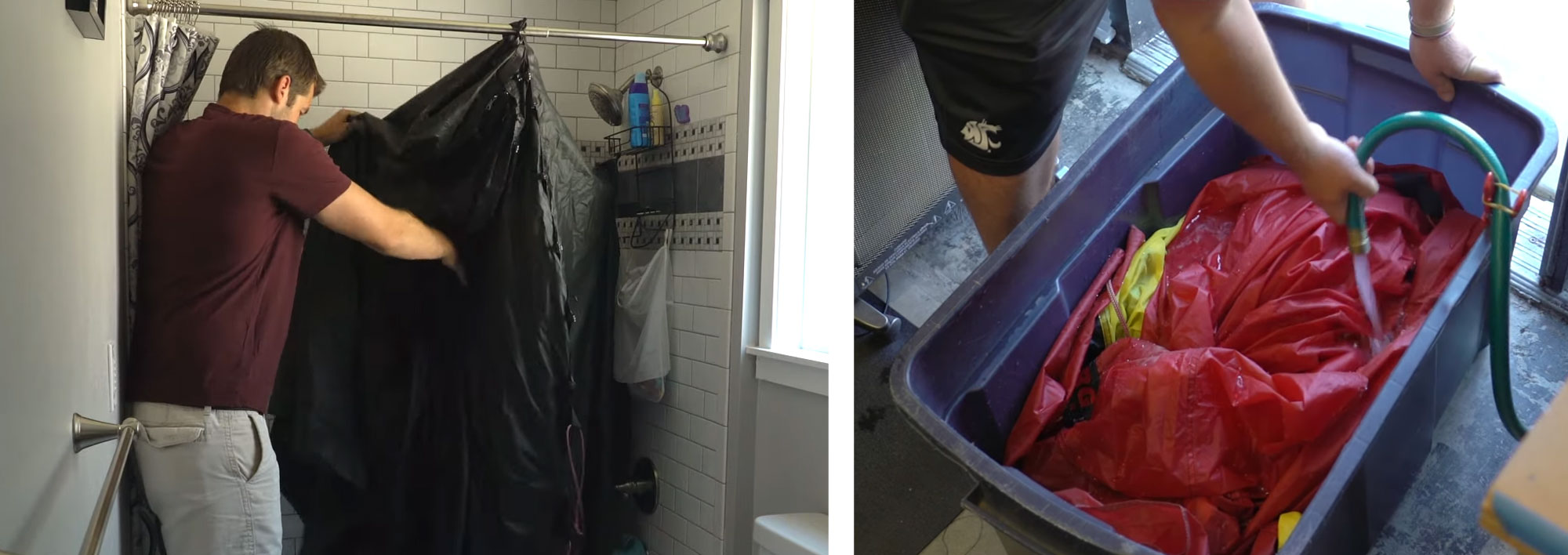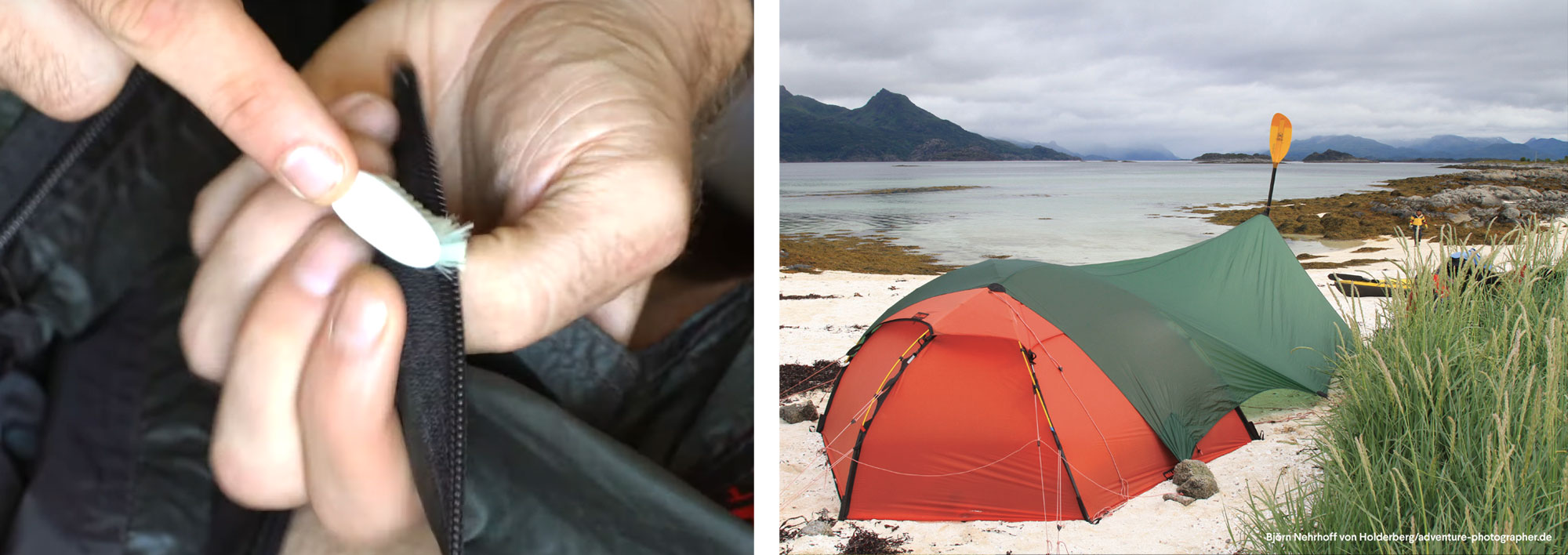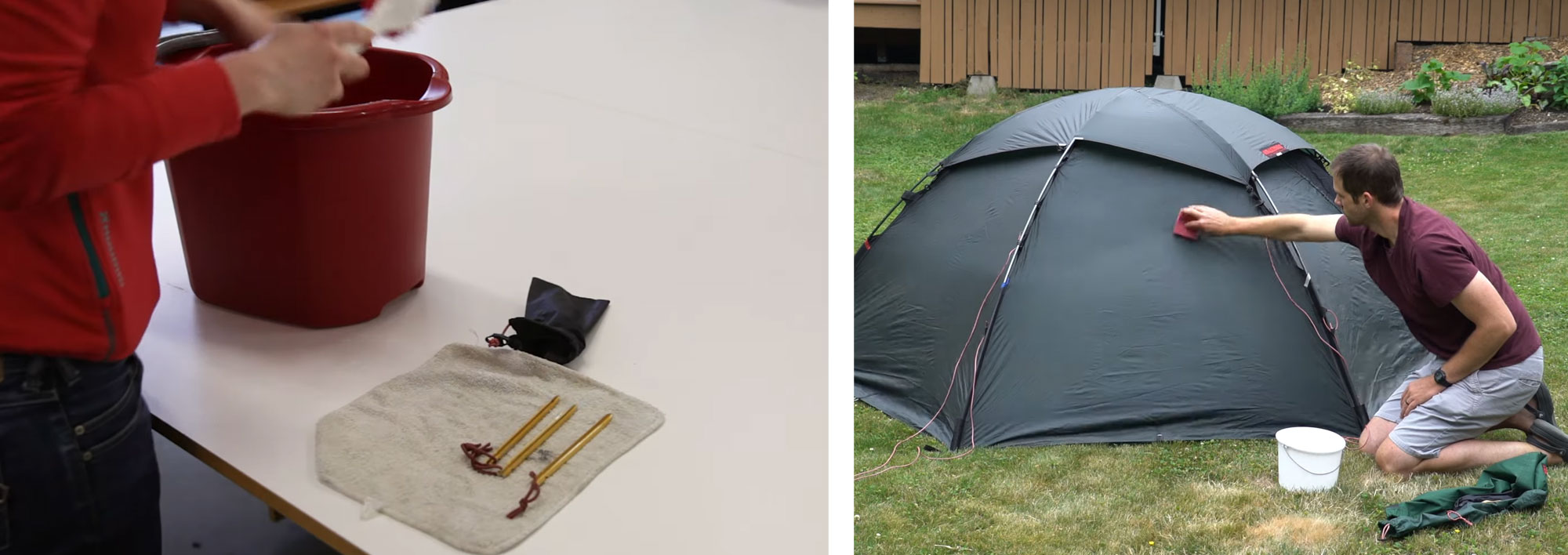Hilleberg Tent Care Guide
Posted by Andy Neil & Hilleberg on Jul 25, 2022

Hilleberg tents are the pinnacle of durability and performance and are designed to last a lifetime. Our customer service team and the experts over at Hilleberg have put their heads together to come up with some tips to help you care for your tent.
Make sure it’s dry
The first and most important, and we all know this, but it happens all the time anyway: never put your tent away wet. That’s not to say every time you take your tent down it must be fully dry. We have all packed up in the rain before, and your tent being wet can’t be helped. At the end of your trip, before you put your tent back into storage, you should make sure it’s bone dry. Ideally, hang it up inside with the poles in it. If there’s no space for that, fold it over a washing line, a stair banister, or a shower curtain. Make sure you turn it a few times so all the nooks and crannies get a chance to dry. Unhook the footprint from the inner tent and make sure it’s dry, as well. Storing a damp tent can result in mold and mildew, and these can cause irreversible damage to a tent.
Stuff or fold?
When I first started going out, I would always lay my tent as flat as I could, fold it into thirds, then neatly roll it up before popping the tent into its stuff sack. Then I discovered that I could easily and simply “stuff” the tent (it is, after all, called a “stuff sack”). Stuffing the tent saves time in the field and can be easier, especially in windy conditions. If you stuff your tent, don’t push your pole bag into the tent bag. Instead, store the pole bag separately in your pack, and make sure the poles aren’t pressed against the tent. If you decide to fold your tent, you should do it so the floor is outermost. Then roll the pole bag inside the folded tent before putting the bundle into the tent bag. At home, fold and roll your tent for long-term storage. Hilleberg does not recommend using compression sacks for their tents, nor do they sell them, for two reasons. First, their tents have fittings that, when pressed against the tent fabrics, could cause wear. Second, compression sacks make the packed tent denser and thus harder to work around when you add other items to your pack. When stored in a Hilleberg tent bag, the packed tent stays malleable and better fills up your pack’s space.

Check your zips!
Make sure all your zips are fully closed before erecting the tent. The zip fastenings take on a lot of pressure and can easily become damaged if we don’t look after them well. I have been guilty of putting the tent up with the zips unfastened, which can result in a misshapen tent. Sometimes after pegging out and tensioning all the guy lines, we will try to zip the tent up from the inside, only to find none of the zips will close. Then what happens is we pull on them too hard, the zip breaks or becomes warped, and we have a tent filled with midges for the night. Before taking down my tent, I always make sure all the zips are closed, so I don’t have to worry about them next time I pitch my tent. And don’t forget to clean them, too!
Pitch late, leave early
“Pitch late, leave early” is the wild campers’ mantra, and it’s a mantra that can help extend the longevity of your tent. Your tent protects you from the weather, so make sure you do it the same courtesy. Over time, the sun’s UV rays (especially at altitude and in the southern hemisphere) damage all fabrics and reduce tear strength. I’m not saying you should never pitch your tent in sunlight, but I am saying you should look at ways to minimize its exposure to it. Pitch your tent in the shade, put a tarp over it, and don’t leave it set up during the day when you don’t need it, or alternatively, pitch when the sun goes down. All Hilleberg tents are treated for UV resistance during dyeing and coating, but the fabrics are lightweight material. If, over time, you feel your tent’s fabric has become UV damaged, you can re-treat it (don’t ever do this on a new tent). Hilleberg recommends using Nikwax Tent & Gear Solar Proof. Set up your tent and wash it with a sponge and lukewarm water. Spray or brush the Tent & Gear SolarProof on the fabric and wipe off any excess liquid. Once the tent has dried it is ready for use. This will reinvigorate the tent’s water repellency and improve protection against UV damage. If the inner of your tent needs reproofing use Nikwax TX.Direct Spray-On which works well on fabrics – like those in the inner tents – that need to have both air permeability and water repellency. As with Tent & Gear SolarProof, spray on the TX.Direct, wipe off any excess liquid, then let it dry.

Use a footprint
Hillebergs are all-around robust tents. Their Red and Yellow Label tent floors are made from 70 denier nylon, with a hydrostatic head of 15,000 mm and their Black Labels tent floors are made with 100 denier nylon with a hydrostatic head of 20,000 mm. Your tent’s floor isn’t likely to get a puncture, and it certainly won’t let any moisture from the ground into your tent, so it’s easy to think you don’t need a footprint. But if you use your tent quite frequently, using a footprint can reduce the risk of punctures and abrasions and can increase the life of the floor. With Hilleberg’s Red and Black Label tents (the Keron, Nammatj, Nallo, Soulo, Akto etc.) the footprint covers the entire vestibule, which helps prevent dampness from the ground from condensing on the inside of the outer tent. One more reason to use a footprint: it can help keep the inner tent clean.
Clean your tent
99% of the time, all you will ever need to clean your tent is a damp cloth, some lukewarm water, and a bit of patience. For extended washes we recommend using cold water. Regarding that 1% of the time, you might ask yourself: Can I simply put the tent in a washing machine? The answer is a definite NO. No washer, no drier, no soap, no, no, and no. The protective silicone coating on the outer tent won’t thank you, and neither will the polyurethane coating on the floor. If you feel you must deeply wash your tent, submerge it in cold water for an hour, agitate it every so often, and then rub it with a damp cloth and let it dry thoroughly. There are a few other tasks you can do to clean your tent, like making sure your zips are clean and free of detritus, especially if you have been using your tent somewhere dusty or sandy. To do this, simply get an old toothbrush and gently clean the teeth of the zip. Don’t forget your poles and pegs would also appreciate a wipe with a damp cloth.

Pay attention to your poles
DAC aluminium poles are the strongest, most flexible, and most durable poles on the market, but they too need some love and attention. The number one cause of poles breaking is impatience. When taking the poles out of the bag, be careful that the shock cord does not snap the poles together. This can cause nicks in the aluminium, which can then go on to cause weak spots that could eventually snap. Ensure each pole section is fully seated by hand when assembling the poles. When feeding the poles through the pole sleeve, never force the pole. If at any point you encounter any tension, stop and make sure the tent isn’t twisted and there is nothing blocking the sleeve. Be sure to seat each pole fully in its pole sleeve end or pole holder cup. When it comes time to take your tent down, remove the poles from the pole holder cups one by one to ease tension. On full sleeves, always push the pole out, never pull it. Pulling will separate the pole sections, which not only makes it difficult to get the pole out of the sleeve, but also puts tension on the shock cord so that it could snap back and damage the pole or tent material. And finally, when folding your poles, always start from the middle and work out, again this puts less tension on the shock cord.
Know how to work with the wind
I know some see 70 mph wind speeds as a thrilling challenge. Your tent may not agree with you. Even in less daunting wind speeds, it is always good to know how to best pitch your tent. Firstly, check the forecast, so you know what sort of a night you are in for. Make use of natural wind shelters like rocks or a gully if you can. Knowing which direction the wind is blowing seems obvious, but taking a leaf or piece of grass and letting it fall is a sure-fire way of determining the wind direction. For single entrance tunnel tents, Hilleberg recommends pitching the entrance into the wind to inflate the tent and increase venting, and so the foot end fabrics aren’t pushed against your feet by the wind. For dual entrance tunnel tents, aim either end into the wind. For the Soulo, Soulo BL, Allak and Enan, the foot end should be placed into the wind. It’s important to make use of and properly tension all your guy lines and put your pegs into the ground at a 45-degree angle. Also pack some ear plugs, they won’t extend the life of your tent, but they might help you get a better night’s sleep. For further tips and tricks, Hilleberg’s website has great resources like pitching videos, instruction booklets and plenty more to refer to.

|
||
 |
||
|
Andy Neil |
||
|
Andy has been a keen long-distance hiker and wild camping enthusiast since he completed the Cleveland Way in 2015. Since then, he has walked thousands of trail miles all over the UK and is an active member of the Wild Camping UK community, being an admin of the largest wild camping community on Facebook. He strongly advocates for responsible wild camping and believes it is important to leave no trace when camping in the wilderness. He joined the UOG team in 2021 and works as a website developer and content creator. |
||
